Quake III: Team Arena Preview
We visited id Software's offices in Texas to play the new Quake III Arena expansion first-hand. Find out everything about the add-on in this extensive preview.
Team Arena, id Software's own expansion pack for Quake III Arena, is finally finished. But since it's just started shipping to most software retailers, we took the opportunity this week to fly out to id's offices in Mesquite, Texas (just outside of Dallas) to play the game. We'll have a full review of Quake III: Team Arena next week - but for now, please join us for a comprehensive look at the many new features in this expansion.
While Quake III Arena was designed for pure deathmatch, free-for-all play, Team Arena seeks to bring the team-play experience to a new level. Though it takes some inspiration from the team maps and game types of Unreal Tournament and Tribes, Team Arena maintains the distinctive Quake feel while introducing a number of small innovations.
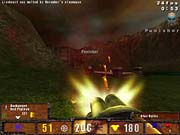
The most impressive new element is the introduction of outdoor maps, which encompass such a large swathe of rolling terrain that they can accommodate up to 64 players per server, which is the Quake III engine's limit. On Team Arena's total of 11 new team maps, you can choose from three new team game types - one-flag capture-the-flag, overload, and harvester - all of which are included in the playable demo that was released last month. Also new are the four persistent power-ups that you can grab at your base for specific abilities - like increased speed or heath regeneration - which encourage players to take distinct team roles. For those looking specifically to play in line with Quake III: Arena, there are four new one-on-one tourney maps; plus, the original four capture-the-flag maps have been updated.
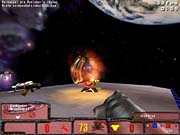
Being team-focused doesn't mean that Team Arena does away with the single-player component. When you can't get a fast Internet connection or find online opponents, the game's bot AI should make for some fun solo team games. In contrast with Quake III's tiered system, in which you had to unlock arenas sequentially, Team Arena introduces a complex scoring system that should have you returning to each map to improve your high score.
The bots have also been updated in order to take strategic team goals into account, and they will now coordinate amongst themselves to defend the base or go on the offensive. There's a simple menu-driven system for giving bots specific team orders, but the bots are smart enough to drop an explicit order if something more pressing comes up. For example, a bot that you've ordered to camp an area will leave its post if it sees an enemy flag carrier or, conversely, to guard its own team's passing flag carrier. Although much of what's new about the bots in Team Arena applies to all bots, the individual bot personalities that were so vocal in Quake III survive in the expansion. Each bot has its preference for taking either an offensive or defensive role; plus, each won't perform all its tasks equally well.
Terrain Maps
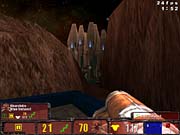
The three outdoor maps included in Team Arena are unlike anything previously seen in a Quake game. While Quake III maps often mix interior corridors with largish open-air arenas, the scale of the outdoor environments is still a magnitude larger. The three maps are each larger than the next, and although the smallest can be fun with only four players per team, the largest is meant for a minimum of eight players per side. All three maps feature extensive base complexes as well as smaller forward platforms, where defenders can survey large expanses of territory and snipe with the railgun. In fact, the possibility of infinite sniping range with custom high-zoom binds has led id to put a hard limit on the railgun's range. Lakes and twisting valleys do make it possible for a covert player to sneak into the enemy base out of the sight of snipers. Still, one map has a base booby trap, where a sentry can activate a switch to launch a hail of grenades into the rear corridor.
Id has made a few significant changes to the Quake III engine so that these big maps are actually less system-hungry than the interior maps, which have more intricate architectural detail. Instead of painstakingly laying out hills and valleys polygon by polygon, Team Arena produces its smoothly rolling terrain by simply defining how high the ground is with a height map. Since the engine is just punching out this 2D topographical information to show elevation, much less data is needed for a large area. This terrain advancement, the work of id programmer Jim Dosé, is actually similar to techniques used in the enormous maps of Tribes and Tribes 2.
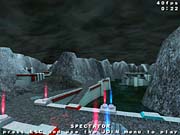
The outdoor maps look remarkably good despite these optimizations. The largest map adopts a winter setting complete with barren trees, a second one is set in a barren, rocky environment, and the third takes place in a green valley. The Team Arena terrain uses a limited palette of textures across a given map, but the engine does a good job of blending textures so that you don't see any tiling. If you look closely at the hills, however, you can see a new, subtle effect - the clouds in the sky cast light shadows on the ground. This comes despite the fact that the terrain is lit with a simpler vertex lighting scheme, which eliminates some of the existing effects, like marks on walls.
The terrain system is the most exciting technology change in Team Arena, and it will certainly make its way to Quake III engine licensees and into future id games. For one, Gray Matter is said to be highly interested in working terrain maps into its upcoming game, Return to Castle Wolfenstein.
More Maps & Items
The other eight new team maps vary in style but echo the sci-fi space maps and Gothic castles seen in Quake III. The third map of the game, which many know from the Team Arena demo, is one of the smaller and more straightforward of the new maps. Many of the larger maps are absolutely cavernous, and, at first, the only way you'll stumble from your base to the opposing team's is to follow the red and blue arrows that label many corridors. The main team space map in Team Arena adds a new type of teleport portal called a vortex portal. The map is divided into three main sections - the two bases and a middle area - each connected by a wormholelike portal that takes several seconds to traverse. Each base has three portals: one that takes you to the middle of the map and two take you straight to the enemy base.
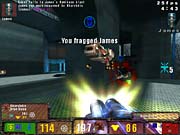
Those who liked the four capture-the-flag maps that came with Quake III will be happy to find that they have all been reworked to support the new game types and the items of Team Arena. Id has also made a few minor tweaks to the maps themselves. Perhaps the biggest change was to the first and smallest of the maps, where stairs - which go down from the pit in the middle into a new lower base area - have been added.
The personal teleporter, one of the less popular items of Quake III, gets a new use in Team Arena. On the couple of maps on which the item is present, there's a special, otherwise inaccessible room or platform to which the teleporter takes you directly. There you'll find the BFG and, in one case, portals straight into both team bases. The teleporter respawns very slowly to balance its newfound power.
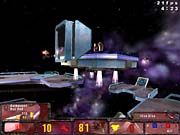
Id has decided to expand the number of carried items in Team Arena by adding the invulnerability sphere and the kamikaze weapon. The invulnerability sphere gives a player nearly the protection from enemy fire by deploying a static force field sphere that lasts for about ten seconds. This sphere of protection, however, will stop you dead in your tracks, so you'll really be much like a turret for those precious seconds. Interestingly, the force field will reflect projectile weapons so that rockets and grenades will actually bounce off and even be able to go back to hit the shooter. The one weapon that's effective against this sphere is the proximity launcher, since mines can stick to the item's wielder just before the field goes up. After a few seconds, mines will explode within the sphere and coat the inside of it with a bubble of blood and guts.
Weapons
Another inventory item, the kamikaze is easily the most powerfully unpredictable weapon in the game. When activated, the kamikaze explodes in a large spherical ball of fire that's big enough to clear most arenas of both friends and foes. Those not immediately killed will be pretty shaken up, as the ground literally moves beneath them. Many people may be a little slow to blow themselves up, but even in death, a player with the kamikaze can strike back - unless the body is gibbed to destroy the item, it will explode several seconds later. As a result, the kamikaze certainly has dramatic flair. When it respawns, a bell sounds - this lets players know when this deadly device is in play.
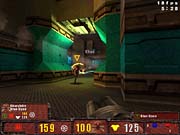
Team Arena adds three new weapons to the standard arsenal to switch things up, and, overall, they are powerful enough to give you an extra edge in big team servers. These are all completely in addition to the ten weapons at your disposal in Quake III, although maps will, of course, always include only a subset of these.
Nailgun: Shooting a dispersed volley of vicious metal shards, this weapon works something like a slower and more powerful shotgun - it is quite unlike its rapid-fire Quake cousin. If you're the bearer of a nailgun, you might appreciate the shimmering trail that follows the volley of nails as they quickly fly across an arena, but your opponent will feel only the 35 points of damage that each nail deals out. This is the only weapon that can take down a fully armored player at close range, and its dispersion makes it one of the best ways to take down a crowd of enemies in a corridor or midsize room. However, because it doesn't instantly hit its targets and reloads quite slowly, the nailgun surely won't replace the shotgun or the rocket launcher.
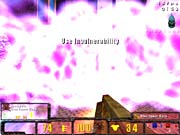
Chaingun: A souped-up version of a Quake III default weapon - the machine gun - the chaingun can take down an enemy just as fast as it burns through ammo. The much faster rate of fire is somewhat offset by the chaingun's larger ammo capacity, so you'll want to be sure to pick up the extra ammo boxes when possible. As with the machine gun, there isn't a noticeable firing delay because the chaingun's barrel spins up; plus, the bullets it fires hit its target instantly. However, the chaingun is much less accurate at a distance, making it primarily a mid-distance weapon.
Proximity launcher: Base defenders have a new treacherous weapon in this sticky mine launcher. Mines will stick to any solid surface - including players - and they are set to detonate whenever an enemy gets too close. Though the mines don't do too much damage individually, few will survive a corridor laden with them. It's possible to clear away mines with a rocket launcher or other weapon that does splash damage. Mines will not hang around forever, though, and will explode on their own after 30 seconds if otherwise inactivated. However, this life span of mines can be customized with a server variable.
Power-ups
Team Arena introduces four permanent power-ups, called runes, which give you a specific ability for as long as you stay alive. All but the largest maps have only one of each type of power-up, and those in use by team members won't respawn until those players fall on the battlefield. Each rune is best suited to certain offensive and defensive roles, so there's likely to be some team pressure for using the runes to their best effect. The power-ups appear on other players as an orbiting color-coded effect that look something like a diagonal sash, so it's really not too hard to tell what you're up against. In any case, you'll want to choose your rune somewhat carefully, since you can't drop it unless you're killed or you kill yourself.
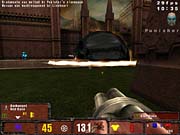
Guard: When you pick up this power-up, both your health and armor will immediately jump up to the maximum level of 200 points. As you sustain damage, guard will regenerate your health backup. Armor, however, is not affected after the initial boost. This rune makes it much tougher to take down a player who wears it, so it's ideal protection for those on the offensive who are making a flag run or base attack.
Doubler: Deal out double damage by picking up this rune. It's a great defensive power-up, since you can take down armored enemies much more quickly. It's even more devastating when combined with the infamous quad damage.
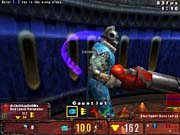
Ammo regen: Watch all your weapons ammo regenerate over time with this rune. Even BFG rounds regenerate, albeit at a very slow rate. Simply regenerating ammo didn't make this a very appealing power-up, so id also gave it the power to increase your firing rate by about one-third. This power-up will let your team's sniper camp in an ideal position without having to leave for additional ammo; plus, the faster firing rate makes it easier to recover from a missed railgun shot.
Scout: Like the haste temporary power-up, scout greatly increases your speed of travel and firing rate. However, you can't pick up any armor while wearing scout. For this reason, it's ideal to have a med kit handy when you go on the offensive with scout. In open areas, it can be very difficult to place a shot on someone who's wearing this rune and dodging skillfully, so he or she can easily wreak a lot of havoc with a powerful and fast weapon like the chaingun.
Final words
Although Quake's multiplayer has traditionally been very focused on just deathmatching, it's clear that id sees how important team games have become to the multiplayer gaming community, especially with the incredible popularity of team-only squad games like Counter-Strike. In addition to all the new maps that id itself has included in Team Arena, a lot of effort has been put into opening the game up so that it's easier for mod authors to customize the user interface for new game features. It's also very easy to add custom clan logos that appear - they replace the standard glowing team images placed around bases.
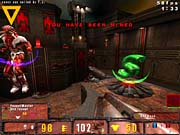
The new mix-and-match system for selecting a player model should also make it somewhat easier to be sure that other players see you in your true colors. Team Arena really has only two main body types, male and female, but it gives you the choice of 11 heads for each. Additionally, each of the five teams has a different body skin. This should make for a fair amount of diversity in games without adding the performance burden created by Quake III's large number of unique player models. Id noticed that many just lock the number of models to one with the "forcemodels" console command.
Although the Team Arena demo has had a largely positive response, many noted that it ran significantly slower at comparable detail levels than Quake III. One explanation is that the Team Arena maps generally use more complex geometry and more animated textures, so the system requirements are a notch higher. Considering how far PC hardware has come in the last year since the release of Quake III Arena, it's natural that the system requirements for Team Arena would increase somewhat. But id was able to also explain an issue we'd had: Even on the most powerful system, the game seemed to intermittently stop for a half second. This seems to be due not to graphics changes, but rather to the sound system. The default setup is designed to let computers with 64MB of system memory run the game, so those with more than that can go in the console and adjust the "com_hunkMegs" to 64 and increase "com_soundMegs" to 16 for optimal performance.
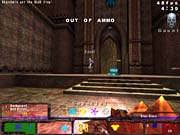
It's natural that the completely rewritten engine in id's upcoming Doom game will take these requirements a step further. Speaking of Doom, Team Arena has kept different departments of id busy while the early design stages of the new game have been sorted out, but the whole development team - which has gone from ten members for Quake III to 14 - will now be dedicated to the new Doom. In the meantime, we'll soon have Team Arena to rejuvenate Quake III. We had only a day to spend with it, and it was tough to leave behind.
Fortunately, the game is already available at some retail outlets, and should be in stores throughout the country the week of December 17.
Got a news tip or want to contact us directly? Email news@gamespot.com
Join the conversation